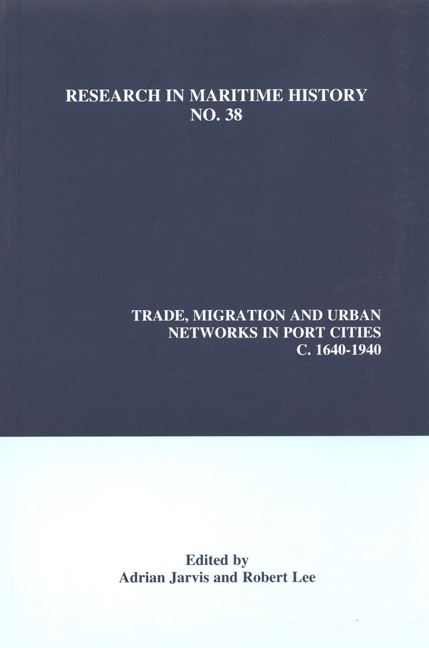Book contents
- Frontmatter
- Table of Contents
- Contributors' Notes
- “Trade, Migration and Urban Networks, c. 1640-1940: An Introduction”
- “Portuguese Jews in Amsterdam: An Insight on Entrepreneurial Behaviour in the Dutch Republic”
- “Contrasting Merchant Communities in the Early Eighteenth Century: Stockholm, Calabar and Charleston”
- “Integration of Immigrant Merchants in Trondheim in the Seventeenth and Eighteenth Centuries
- “In the Eye of the Storm: The Influence of Maritime and Trade Networks on the Development of Ostend and Vice Versa during the Eighteenth Century”
- “Exploiting International Webs of Relations: Immigrants and the Reopening of the Harbour of Antwerp on the Eve of the Nineteenth Century”
- “Migrants, Merchants and Philanthropists: Hierarchies in Nineteenth-Century Greek Ports”
- “Port Cities, Diaspora Communities and Emerging Nationalism in the Ottoman Empire: Balkan Merchants in Odessa and Their Network in the Early Nineteenth Century”
- “Combining Business and Pleasure? Cotton Brokers in the Liverpool Business Community in the Late Nineteenth Century”
“In the Eye of the Storm: The Influence of Maritime and Trade Networks on the Development of Ostend and Vice Versa during the Eighteenth Century”
- Frontmatter
- Table of Contents
- Contributors' Notes
- “Trade, Migration and Urban Networks, c. 1640-1940: An Introduction”
- “Portuguese Jews in Amsterdam: An Insight on Entrepreneurial Behaviour in the Dutch Republic”
- “Contrasting Merchant Communities in the Early Eighteenth Century: Stockholm, Calabar and Charleston”
- “Integration of Immigrant Merchants in Trondheim in the Seventeenth and Eighteenth Centuries
- “In the Eye of the Storm: The Influence of Maritime and Trade Networks on the Development of Ostend and Vice Versa during the Eighteenth Century”
- “Exploiting International Webs of Relations: Immigrants and the Reopening of the Harbour of Antwerp on the Eve of the Nineteenth Century”
- “Migrants, Merchants and Philanthropists: Hierarchies in Nineteenth-Century Greek Ports”
- “Port Cities, Diaspora Communities and Emerging Nationalism in the Ottoman Empire: Balkan Merchants in Odessa and Their Network in the Early Nineteenth Century”
- “Combining Business and Pleasure? Cotton Brokers in the Liverpool Business Community in the Late Nineteenth Century”
Summary
Introduction
In the Austrian Netherlands Ostend was the sole mercantile port city with an international character. Situated in the southern part of the North Sea and surrounded by major ports (including London, Dunkirk and Rotterdam) belonging to the main maritime nations of the eighteenth century, Ostend had become quite attractive to merchants and entrepreneurs who wanted to develop or expand their business networks on the Continent or in the British Isles.
During the last three decades of the eighteenth century these networks reached as far as North America, the West Indies and East Asia. Surprisingly, however, the trade opportunities and buoyant business environment hardly affected the demographic evolution of the town throughout the first half of the eighteenth century. The population of Ostend fluctuated in this period between 5000 and 6000 inhabitants. In 1698 the town had 5728 citizens, but this number dropped markedly during the War of the Spanish Succession to 5000. After 1770 the population increased and doubled during the early 1780s. This phenomenon can be explained by the fact that Ostend functioned mainly as a transhipment port and a distribution centre. Besides a few maritime enterprises like shipyards, ropewalks and sawmills, hardly any proto-industries were established in or around the town. Moreover, the optimal waterway connections with Bruges, Ghent and Dunkirk, which existed from the mid-seventeenth century, made it unnecessary for entrepreneurs from Flanders and the north of France to move their companies to the coast. To stimulate traffic between the port and the inland towns, the Bruges-Ostend Canal was opened in 1623 and was further improved in 1666-1669 to allow small seagoing vessels to sail as far as Bruges. In 1672-1676 a massive sluice was constructed on the canal in Slijkens, five miles south of Ostend, to improve this connection. From 1641 onwards, Ostend profited from the opening of a new canal between Bruges and Dunkirk, which was mainly navigated by barges.
As a result, Ostend did not experience rapid demographic expansion in the eighteenth century similar to port towns, such as Rotterdam, Cork or Dunkirk, which were less dependent economically on other urban centres. On the other hand, the population explosion of the 1780s was due to massive immigration during the Fourth Anglo-Dutch War when the Austrian Netherlands was neutral.
- Type
- Chapter
- Information
- Publisher: Liverpool University PressPrint publication year: 2008



